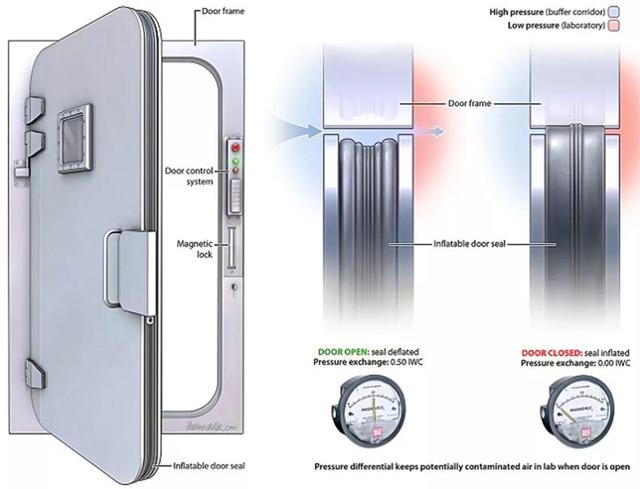洁净间怎么控制压差(洁净室压差控制详解)
背景:
某项目优化意见:
洁净室FFU上静压层是否有必要增加对外部的压差传感器,以便于观察天花上压力情况
原因分析:一般情况FFU上静压层为正压,密封未做好或其他原因可能导致为负压。增加对外压差主要为了实时观测对外压差。
1答:
理论上上夹层应该是要保持正压
洁净室所有区域的负压只是相对于工作区而言,而不是室外
我这边在上夹层特意安装了两个压力探测器 只监视 0--5范围超出报警
所有压力的基准取非洁净室的一个点位
如果工作层只保持10pa,基本下夹层,回风夹道,上夹层基本都是负压相对室外
2答:
洁净室(www.wuchenshi.com)正压10pa,
回风道压降15Pa,
DCC压降30Pa ,
FFU夹层压力=10-(15 30)=-35Pa.
洁净室压差如何控制?超范围,需要立即写偏差吗?
关于压差报警限的制定,建议设定为日常监测上限-(2~3Pa)或压差下限 (2~3Pa)
“After observing and recording the normal operating ranges, it is recommended that a pressure setting for the warning pressure measurement device be selected a few Pascal below the lowest pressure observation for a positive-pressure configuration, or a few Pascal above in a negative-pressure configuration (guidance value 2 Pa to 3 Pa). 观察和记录正常操作范围后,建议对压力报警装置设定一个压力报警范围值,对于一个正压装置,设定所观察到的最低压力值-(建议2-3Pa)作为报警值;对于一个负压装置,则 (建议2-3Pa)作为报警值。
关于压差报警,允许对压差报警设定延时,以满足日常操作需要(如进出开门),但需要合理确定该项活动所需要的时间,并以此确定延时。
“It is often necessary to delay the alert or action alarm to allow for normal activity in the cleanroom, such as the opening of doors to permit entry and exit of personnel. Careful observation of the duration of typical or expected normal deviation is necessary to determine appropriate time delay.Deviations that extend beyond the normal durations should activate warnings.
通常需要延迟报警或行动警报,以允许洁净室的正常活动,如开门以允许人员进出。仔细观察典型的或预期的正常偏差的持续时间是确定适当的时间延迟的必要条件。超出正常持续时间的偏差应激活报警。
有关缓冲间门的要求,除非安装充气密封(equipped with inflatable seals),否则开门后压差存在泄漏(客观事实)。
Air locks are designed to help maintain pressure differentials as personnel or
materials move from one cleanroom or clean zone to another. Air locks are designed or operated so that one opposing door set is always closed. However, unless the doors are equipped with inflatable seals, the leakage through the airlock is usually greater when one of the opposing door sets is open than when they are both closed.
当人员或物料从一个洁净室(www.wuchenshi.com)或洁净区移动到另一个洁净室或洁净区时,气闸(缓冲间)的设计有助于保持压差。气闸的设计或操作使一个相对的门总是关闭。然而,除非这些门装有充气密封,否则当其中一扇门打开时,通过气闸的泄漏量通常比两扇门都关闭时更大(客观事实)。

关于缓冲间压差的监测要求:应监测开关门后压差恢复的情况,确保压差恢复后才能打开另一道门。
It is necessary to test and document these normal variations to properly set alert and action levels for pressure alarms. Follow this procedure: 有必要测试和记录这些(开关门)常规压差变化,以便为压力报警设定适当的警戒和行动限。参照以下程序进行评估:
- close all doors and pass-through hatches, define the operational status of any equipment, and observe the steady-state pressure differentials between the selected rooms or zones noting the small, normal fluctuations that will occur due to wind and other dynamic effects;
- 关闭所有的门和传递窗,定义所有设备的运行状态,观察稳定状态下所选择的房间或区间的压差,注意由于风或其它动态影响产生的小的常规波动;
- for each airlock, pass-through hatch or transfer chamber, open allthe doors, one set of opposing doors at a time, and note room- or zone-pressurevariation. Close the doors and confirm that the pressure differentials return to theiroriginal values;
- 每个缓冲间、传递窗或转移舱,打开所有的门,一次打开一边的门,注意房间或区间压力波动。关门,确认压差回到其原始值;
- leakage paths, such as those around doors, should be evaluated as part of a cleanroom design to ensure adequate allowance is made in the air balance for such leakages. 泄漏通道,例如门周边泄漏,应进行评估,作为洁净间设计的一部分,以确保为此泄漏做出了足够的空气平衡余量。
,
免责声明:本文仅代表文章作者的个人观点,与本站无关。其原创性、真实性以及文中陈述文字和内容未经本站证实,对本文以及其中全部或者部分内容文字的真实性、完整性和原创性本站不作任何保证或承诺,请读者仅作参考,并自行核实相关内容。文章投诉邮箱:anhduc.ph@yahoo.com






